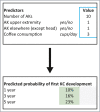Predicting keratinocyte carcinoma in patients with actinic keratosis: development and internal validation of a multivariable risk-prediction model
- PMID: 31856292
- PMCID: PMC7496285
- DOI: 10.1111/bjd.18810
Predicting keratinocyte carcinoma in patients with actinic keratosis: development and internal validation of a multivariable risk-prediction model
Abstract
Background: Patients with actinic keratosis (AK) are at increased risk for developing keratinocyte carcinoma (KC) but predictive factors and their risk rates are unknown.
Objectives: To develop and internally validate a prediction model to calculate the absolute risk of a first KC in patients with AK.
Methods: The risk-prediction model was based on the prospective population-based Rotterdam Study cohort. We hereto analysed the data of participants with at least one AK lesion at cohort baseline using a multivariable Cox proportional hazards model and included 13 a priori defined candidate predictor variables considering phenotypic, genetic and lifestyle risk factors. KCs were identified by linkage of the data with the Dutch Pathology Registry.
Results: Of the 1169 AK participants at baseline, 176 (15·1%) developed a KC after a median follow-up of 1·8 years. The final model with significant predictors was obtained after backward stepwise selection and comprised the presence of four to nine AKs [hazard ratio (HR) 1·68, 95% confidence interval (CI) 1·17-2·42], 10 or more AKs (HR 2·44, 95% CI 1·65-3·61), AK localization on the upper extremities (HR 0·75, 95% CI 0·52-1·08) or elsewhere except the head (HR 1·40, 95% CI 0·98-2·01) and coffee consumption (HR 0·92, 95% CI 0·84-1·01). Evaluation of the discriminative ability of the model showed a bootstrap validated concordance index (c-index) of 0·60.
Conclusions: We showed that the risk of KC in patients with AK can be calculated with the use of four easily assessable predictor variables. Given the c-index, extension of the model with additional, currently unknown predictor variables is desirable. Linked Comment: Kim et al. Br J Dermatol 2020; 183:415-416.
© 2019 The Authors. British Journal of Dermatology published by John Wiley & Sons Ltd on behalf of British Association of Dermatologists.
Figures

Comment in
-
Developing a risk prediction model for keratinocyte carcinoma in patients with actinic keratosis.Br J Dermatol. 2020 Sep;183(3):415-416. doi: 10.1111/bjd.18966. Epub 2020 May 10. Br J Dermatol. 2020. PMID: 32390191 Free PMC article. No abstract available.
References
-
- Saladi RN, Persaud AN. The causes of skin cancer: a comprehensive review. Drugs Today (Barc) 2005; 41:37–53. - PubMed
-
- Naldi L, Chatenoud L, Piccitto R et al Prevalence of actinic keratoses and associated factors in a representative sample of the Italian adult population: results from the Prevalence of Actinic Keratoses Italian Study, 2003–2004. Arch Dermatol 2006; 142:722–6. - PubMed
-
- Flohil SC, van der Leest RJ, Dowlatshahi EA et al Prevalence of actinic keratosis and its risk factors in the general population: the Rotterdam Study. J Invest Dermatol 2013; 133:1971–8. - PubMed
-
- Vatve M, Ortonne JP, Birch‐Machin MA et al Management of field change in actinic keratosis. Br J Dermatol 2007; 157 (Suppl. 2):21–4. - PubMed

